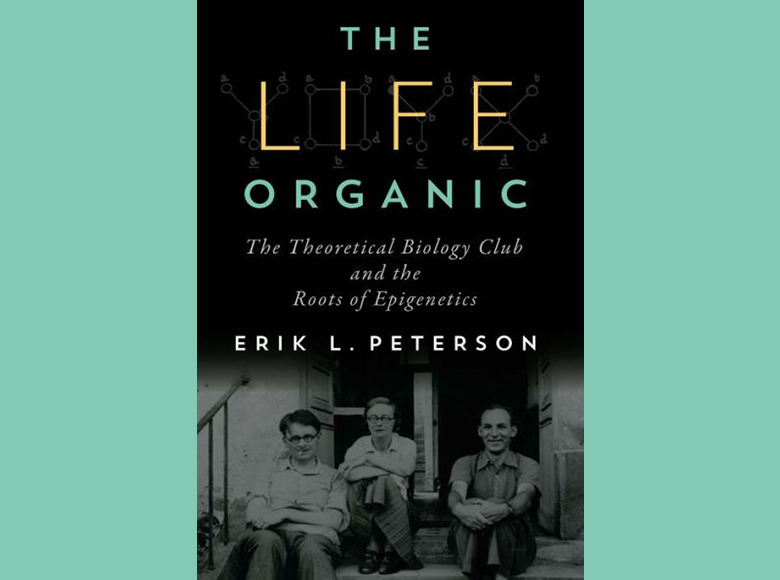“Here I Go Again”—will Waddington’s hopes finally be fulfilled? Part III
by Erik L Peterson
4 April 2018

Question 3: Why didn’t Waddington’s attempts fix the division?
Answer 3: It’s complicated, but two factors jump out.
I devoted chapters of a book to this question, so forgive me for not doing it justice here. I want to focus just on two important reasons. The first is that Waddington and epigenetics became associated with Lamarckism and Lamarckism became a dirty word in biology. In order to understand this reason, we have to go back to one of the darkest episodes in the history of science: the Lysenko story.
Over the course of the 1930s, Trofim Lysenko rose from obscurity to become the chief agronomist in the Soviet Union by promising spectacular gains in grain production by applying temperature shocks to seeds, a well-known process called vernalization. But Lysenko made this not only the formal agricultural policy of the Soviet Union by 1948, but classified Mendelian genetics as reductionist, capitalist heresy and denounced hundreds of his rivals for being Mendelians. These included Nikolai Ivanovich Vavilov, among the most important plant geneticists in the USSR and a friendly colleague of Western geneticists. Authorities sentenced Vavilov to life in prison after Lysenko denounced him in 1940. He died in prison less than three years after his arrest.
What’s less often discussed is the reaction of prominent Western geneticists to this account. In 1947, H. J. Muller, Julian Huxley, and Theodosius Dobzhansky learned of their friend Vavilov’s death. They began a coordinated campaign to memorialize Vavilov and demonize Lysenkoism. Muller, who had worked alongside Vavilov in Leningrad, was especially vehement in his commitment to scrub any hint of Lysenkoism out of American biology. It soon became clear that what Muller meant by “Lysenkoism” was any environmental influence on inheritance or what he called “anti-genetic thinking.” Several times, he attacked the editors of major journals for publishing anything that hinted at the inheritance of acquired characteristics. And though years earlier Muller had been an avowed socialist, during the McCarthy era he sat back while young scientists lost university jobs merely for mentioning that Lysenko’s science had not had a fair hearing in the West.
Perhaps unaware of these developments, Waddington published essays in 1948 & 49 in the New Statesman and Nation, the leading progressive outlet in the UK, advocating a more nuanced look at Lysenko’s science, while justifiably condemning Lysenko’s political behavior. Though he said it with heavy qualifications, Waddington admitted that Muller and other American geneticists were predisposed to reject any work coming out of Lysenko’s lab, so, by Waddington’s lights, there had been no fair analysis of the science.
In 1960, Waddington traveled with a contingent of British scientists to tour laboratories in the Soviet Union and China. Among the most important of his stops was the Moscow Institute of Genetics of the Academy of Sciences—in other words, Waddington visited Lysenko’s lab. In a small self-published account, he described the day—Wednesday, September 19—that he spent with Lysenko and two assistants, Kushner and Gluschenko. While Waddington found Lysenko himself to be a “shrewd secretive peasant with a deeply felt mystical feeling about Nature and a considerable inferiority complex about orthodox science,” Kushner and Gluschenko deserved more respect. They had found through their careful transplantation and crossbreeding work “peculiar phenomena which cannot be explained easily, if at all, by conventional genetics….” Waddington did not speculate more on the theory behind these particular findings. But he did not dismiss them. And throughout this visit to Communist laboratories, and after his return to the Anglo-American scientific world, Waddington remained far more open-minded regarding Lysenko-esque biology than peers such as Muller tolerated—a factor that I think had profoundly negative socio-political implications for Waddington’s appeals to the integration of embryology and genetics.
A second reason why the attempts in mid-20th century to integrate development and inheritance did not stick relates to what Waddington called “the Conventional Wisdom of the Dominant Group” or “COWDUNG.” For Waddington, COWDUNG meant the preference for quantity over quality and simplicity over complexity that drives contemporary biological research—the hunt for the “quick (scientific) buck” (Tools for Thought, 1977, p. 23-24). By the 1970s, he feared the biology of inheritance and development really just meant a hunt for genes-for any interesting phenotypic trait—not, as Waddington was fond of saying, the kind of world-changing biology done by Charles Darwin, among others. In fact, he expressed despair that the pragmatic desire to generate novelty to get grant money to get something published overwhelmed the much slower attempt to get a grasp on the deep mysteries of living processes. During his final works in the 1970s, Waddington, for instance, turned from collaborations with biologists to work with mathematicians, like Rene Thom and Erik Christopher Zeeman in the hopes of applying catastrophe theory to development and evolution.
Meanwhile, the Animal Genetics at Edinburgh, which had long maintained a division between practical breeding on the one side and the “morphogenesis” side, run by Waddington, closed Waddington’s side. After retirement in 1969, Waddington moved to the US and occupied the Einstein Chair at the State University of New York–Buffalo, created specifically for him to bring together developmental biology and genetics. But there Waddington saw a different version of the quest for a quick buck; in a push to eliminate “wasteful spending,” Republicans in the New York legislature eliminated his chair entirely in 1971.
Question 4: Can epigenetics or evo-devo fix the split?
Answer 4: These approaches sure have a lot of momentum, but so does the push-back against them.
From the work that I’ve done on this question, it seems that how scientists define “epigenetics” also falls into two broad camps that, predictably, fall into our old meta-theoretical camps. One group, I call it the “epigenetics-W” group, since it follows Waddington’s original definition, asks how whole organisms are formed by a multitude of inputs, the genome being one of them. By the 1980s, this was reduced to cell fate mapping and absorbed into stem cell research. “Epigenetics-H” follows the 1980s work of Robin Holliday who defined epigenetics as alterations in gene function without alterations in the DNA sequence. But, importantly, this more popular version of epigenetics is still largely interested in chromosomes residing in the nucleus.
Question 5: Are we at a different sort of a historical moment where we might actually witness this split come to an end?
Answer 5: This, of course, I can’t answer (despite the fact this question is in the title of this essay).
Recent conversations with Eva Jablonka among others make me hopeful that there is something new happening. The presence of this fantastic EES group and the “Third Way” folks are two important indicators that something greater than fifty years ago is in the offing.
If the study of the history of biology reveals anything certain on this question, it’s that the discussion about integrating development and inheritance into what has been called an Extended Evolutionary Synthesis is not new. And I don’t mean that because books about it appeared at the close of the Human Genome Project a decade-and-a-half ago. These concerns about healing the divide between development and inheritance, thereby refining the definition of evolution seem to emerge and recede across the whole of the twentieth century and now into the twenty-first with the regularity of a pendulum. What implications that has for our larger understanding of biological history, we’ll have to set aside for conversation over a pint or two.
This is a three-part miniseries:
Part I: How did the split between development and inheritance come about?
Part II: How did biologists attempt to mend the split between development and inheritance in the past?
Part III (this post): Why didn’t Waddington’s attempts to fix the division between development and inheritance work?
